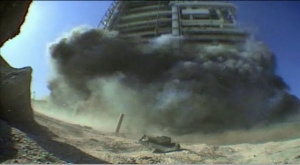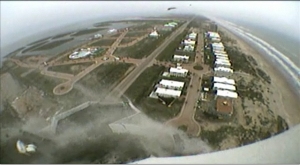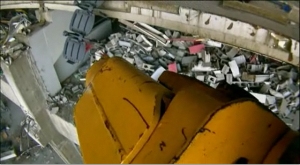OK.
Three months after we started sourcing gear for rent and sale for our first 3D shoot – for the explosive demolition series Blowdown – we’ve narrowed down a camera … we think.
The final showdown was between the SI-2K and the Iconix.
Before I go into which one we chose and why, it’s probably useful to explain exactly what we need them for.
This episode of Blowdown requires more than twenty 3D cameras:
– Two to film actuality and main story beats.
Our camera needs for this:
1. “A” camera system. Portable and operated by one person. This is when suppliers told us – “can’t be done.”
2. “B” camera Rig. As above – but for close-ups.
-18+ POV and kill cams capturing large and small scale on-site action and the actual implosions – which in the case of the Fonte Nova stadium will be many.
I’ve inserted screen grabs of the types of POVs we capture:

To get the dynamic idea of what these kill cams, mounted to the structures Controlled Demolition implodes, have to stand up to, watch them in action.
These are our money shots. And I won’t compromise on them: to capture the Blowdown like this, from inside the actual structure, we demand the footage from these cameras survive dynamite, concrete and rebar, and the free-fall of a complete structural collapse.
The Fonte Nova stadium a 100,000+ seater that’s been modified a few times, so is being brought down in sections.

So how do we get this done in the third dimension?
For the A-camera we decided to try for a two camera side-by-side system with an interaxial distance of 65 mm or less – a duo of small HD cigar type cameras that can spit out a bit rate of at least 100 MB to meet broadcast requirements yet can be operated by one person, running around the field shooting (ie. No room for Avatar-esque static power, tethers and monitors on this shoot).

For the side-by-side we looked at the Iconix and the SI-2K. Here’s what we found:
– The SI-2K has a 2/3 inch sensor. The size of the unit was such that the minimum interaxial would have been 72 mm – so it was too wide for us to be able to handle in the field.
– The Iconix has a 1/3 inch sensor. It’s smaller, but it still provides adequate quality – the benefit being that cameras with lenses are small enough that we can get the interaxial down to 35 mm … less than our 65 mm benchmark.
Based on our calculations this will get us in the range that we need to comfortably shoot characters moving around on a handheld system.
So after much debate, the Iconix it is!
Now we have to figure out how to rig it …

